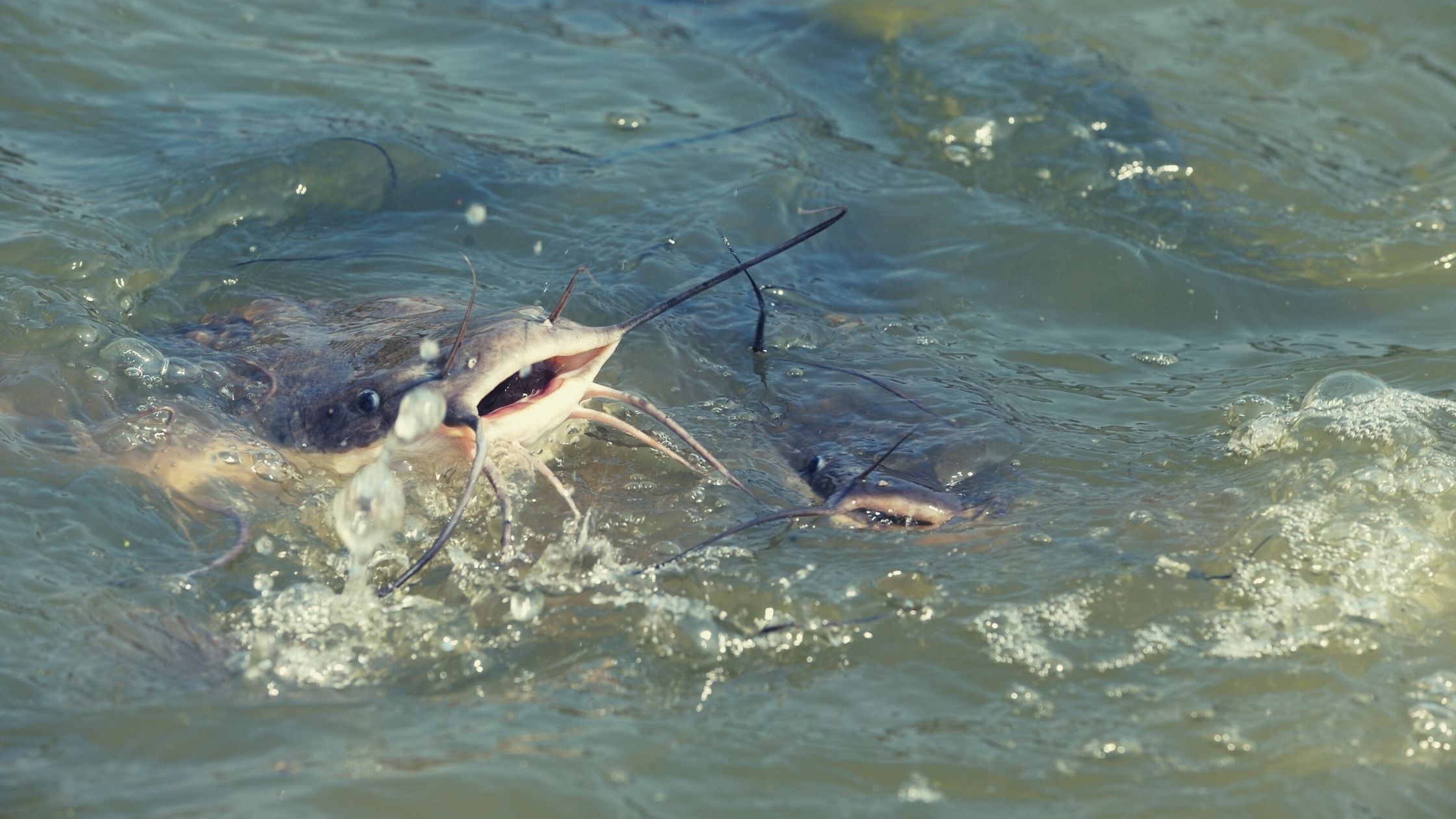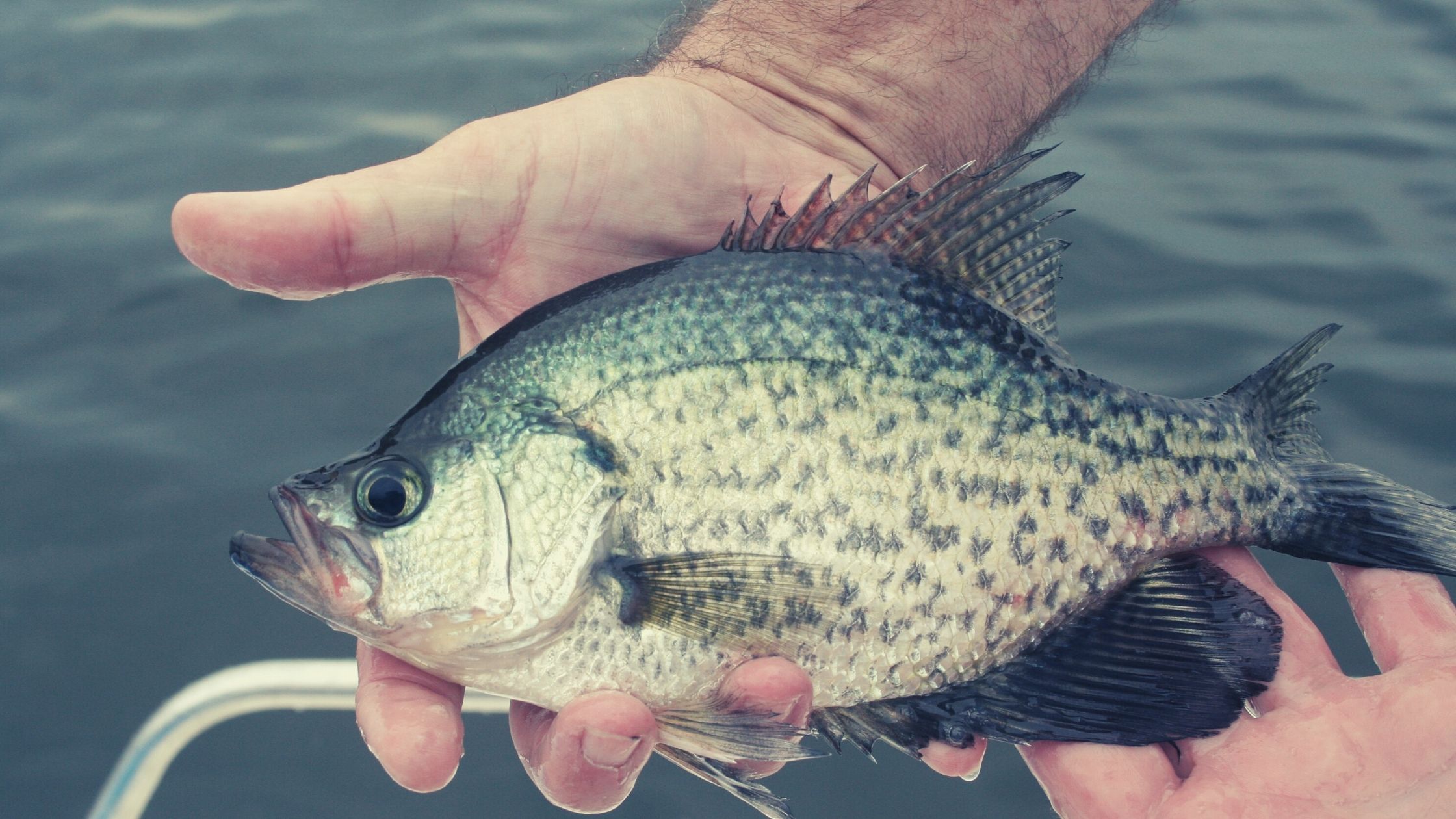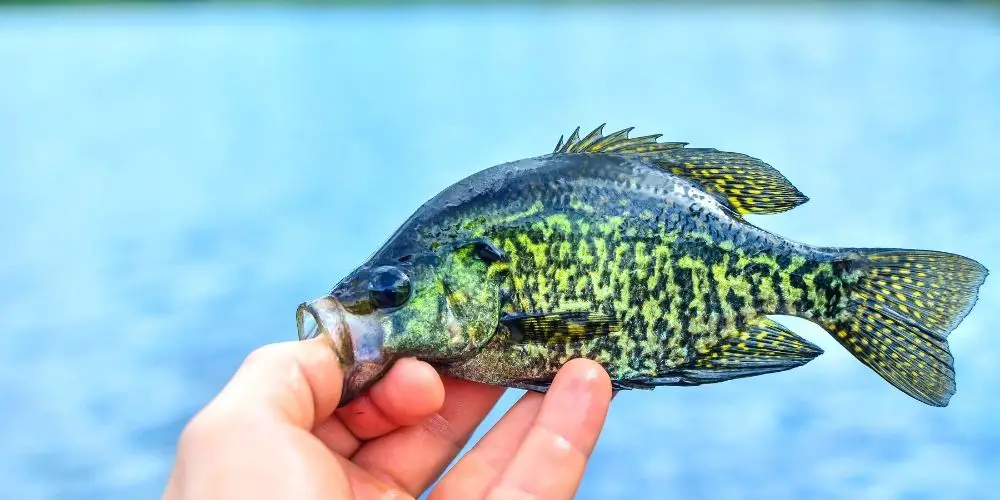Are you curious about the feeding habits of crappie? Well, hold on tight because we’re about to dive deep into the world of these fascinating fish.
Picture this: you’re standing by a serene lake, casting your line, hoping to reel in a crappie. But here’s the thing – do crappie feed at the bottom?
In this article, we’ll explore whether crappie are indeed bottom feeders, what influences their feeding behavior, and how you can best entice them with the right bait.
So let’s get started and unravel the secrets of crappie feeding patterns.
Key Takeaways
- Crappie are opportunistic feeders, eating whatever prey is available.
- They congregate around submerged structures to ambush their prey.
- Bottom feeding provides access to a variety of food sources and allows crappie to conserve energy.
- Water temperature and prey availability greatly impact crappie’s feeding patterns.
Importance of Understanding Crappie Feeding Behavior
Understanding crappie feeding behavior is important for you to become a successful angler. Crappie, also known as speckled perch or papermouths, are known for their unique feeding habits. They are opportunistic feeders, meaning they will eat whatever prey is available to them. Their diet primarily consists of smaller fish, insects, and crustaceans.
Crappie tend to feed more actively during certain times of the day, such as dawn and dusk, as well as during low-light conditions. They are known to congregate around submerged structures, such as fallen trees or brush piles, where they can easily ambush their prey.
Additionally, understanding how crappie behavior changes with the seasons can greatly increase your chances of catching them. By studying their feeding habits and behavior, you can strategically plan your fishing trips and select the best bait and techniques to attract these elusive fish.

What Do Crappie Eat?
Crappie love to munch on small fish, insects, and crustaceans. Their diet consists of a variety of prey items, which they actively search for and consume. When it comes to feeding behavior, crappie exhibit several interesting characteristics:
Opportunistic feeders: Crappie are skilled hunters and will seize any chance to grab a meal. They are constantly on the lookout for potential food sources.
Ambush predators: Crappie prefer to lie in wait, hidden among vegetation or near structures, ready to strike at unsuspecting prey. Their camouflage and stealth make them formidable predators.
Visual hunters: Crappie rely heavily on their keen eyesight to locate prey. They use their excellent vision to detect movements and patterns that signal the presence of food.
Dynamic diet: While small fish, insects, and crustaceans form the primary components of their diet, crappie are known to adapt to different ecosystems and consume a wide range of prey species.
Understanding the crappie diet and feeding behavior is crucial for anglers and researchers alike. By unraveling their dietary preferences and hunting strategies, we can gain valuable insights into their ecological role and contribute towards their conservation efforts.
Factors Influencing Crappie Feeding Habits
When it comes to factors influencing your crappie’s feeding habits, water temperature and available prey play a crucial role.
It is a common misconception that crappie are solely bottom feeders, but their feeding habits are actually more complex.
Water temperature affects the metabolism and activity levels of crappie, ultimately influencing their feeding behavior.
In colder water, crappie tend to be less active and feed less frequently. As the water temperature rises, their metabolism increases, leading to more active feeding.
Additionally, the availability of prey is another important factor. Crappie feed on a variety of organisms, including insects, small fish, and crustaceans.
The abundance and accessibility of these prey items greatly impact the feeding patterns of crappie.
Understanding these factors is essential for successful crappie fishing, allowing you to adapt your techniques based on the prevailing conditions.
The Role of Bottom Feeding in Crappie Diet
To better understand how crappie’s diet is influenced by their feeding habits, you should consider the role of bottom feeding. Bottom feeding is an important aspect of the crappie’s diet, as it allows them to access a variety of food sources that may not be available in other parts of the water column.
Here are four key points to consider about the importance of bottom feeding in the crappie diet:
- Food sources: Bottom feeding provides crappie with access to a wide range of food sources, including insects, small crustaceans, and aquatic vegetation. These food sources are crucial for the crappie’s growth and survival.
- Energy efficiency: Bottom feeding allows crappie to conserve energy by feeding on stationary or slow-moving prey items. This is especially beneficial during periods of low food availability or when energy reserves are needed for reproduction.
- Temperature regulation: Water temperature plays a significant role in crappie feeding behavior. In colder water, crappie tend to be more active bottom feeders, seeking out warmer areas near the bottom where prey may be more abundant.
- Competitive advantage: Bottom feeding gives crappie a competitive advantage over other fish species that primarily feed in the water column. By utilizing this feeding strategy, crappie can access food sources that may be overlooked by other fish, increasing their chances of survival and growth.
Understanding the impact of water temperature on crappie bottom feeding is crucial for fisheries management and conservation efforts. By considering these factors, we can gain valuable insights into the dietary preferences and feeding habits of crappie, ultimately leading to better management strategies for their populations.
Common Misconceptions About Crappie Feeding Patterns
One common misconception about crappie feeding patterns is that they only eat small fish. However, crappie have a diverse diet that includes more than just small fish. While they do feed on small fish, their diet also consists of insects, crayfish, and other aquatic organisms.
Crappie are opportunistic feeders, meaning they will eat whatever is readily available and suits their needs. They have been observed using bottom feeding techniques, such as searching for food in vegetation, rocks, and submerged structures. These bottom feeding techniques allow them to target prey that may be hiding or seeking shelter.
Techniques for Targeting Bottom-Feeding Crappie
Using a variety of bait options and fishing near submerged structures can be effective techniques for targeting crappie that feed near the bottom. Crappie are known for their ability to find food in lower depths, making bottom fishing techniques crucial for a successful catch.
Here are four techniques to consider:
- Jigging: Attach a lightweight jig to your line and bounce it off the bottom to mimic the movement of prey. Crappie are attracted to this action and will strike.
- Drop Shotting: Tie a small hook above a sinker and let it rest just above the bottom. This technique allows you to present the bait at the crappie’s preferred feeding depths.
- Vertical Jigging: Lower your jig straight down and use short, sharp movements to entice crappie. This technique is particularly effective near submerged trees or brush piles.
- Slip Bobber Fishing: Set your bobber to the desired depth above a small hook and bait. This method allows you to present the bait at various depths, targeting crappie at their feeding level.
Best Baits and Lures for Enticing Crappie on the Bottom
If you want to entice crappie on the bottom, try using live minnows or small plastic grubs as bait. These are considered the best techniques for targeting bottom-feeding crappie.
Live minnows are particularly effective as they mimic their natural prey and trigger a feeding response. When using live minnows, it’s important to hook them through the lips or back to keep them alive and swimming naturally.
Small plastic grubs are also highly effective lures for bottom-feeding crappie. Opt for colors that imitate small insects or baitfish. Rig them on a jig head and work them slowly along the bottom, mimicking the movement of natural prey.
These techniques, along with the use of appropriate lures, can greatly increase your chances of success in enticing crappie on the bottom.
Seasonal Variations in Crappie Feeding Behavior
During certain seasons, crappie tend to alter their feeding behavior. Understanding these seasonal variations is crucial for successful fishing. Here are four important factors to consider:
- Temperature: Crappie are more active and tend to feed more aggressively when water temperatures are between 55°F and 65°F. As temperatures rise or fall outside this range, their feeding behavior slows down.
- Spawn: During the spawning season, crappie focus more on reproduction than feeding. They can become less interested in biting lures or baits.
- Prey Availability: Crappie are opportunistic feeders and will adjust their feeding patterns based on the availability of their preferred prey, such as minnows, insects, or small crustaceans.
- Water Clarity: Crappie rely on their vision to locate their prey. In muddy or murky water, their feeding behavior may decrease due to limited visibility.
Understanding these seasonal variations will help debunk the common misconception that crappie are solely bottom feeders. By adapting your fishing techniques to their feeding behavior, you can increase your chances of a successful catch.
Tips for Locating Crappie in Bottom-Feeding Areas
Now that you understand the seasonal variations in crappie feeding behavior, let’s explore some techniques for locating crappie in their preferred bottom-feeding areas.
Crappie are known to congregate around structures such as fallen trees, brush piles, and submerged vegetation, as these provide cover and attract prey. When searching for crappie, pay attention to the depth and structure of the water body. Use a fish finder or depth finder to locate areas with submerged structures.
Additionally, keep an eye out for signs of crappie activity, such as schools of baitfish or surface disturbances. Once you’ve identified a potential hotspot, try using a combination of live bait or artificial lures that mimic the prey species crappie feed on, such as minnows or small jigs.
Conservation Considerations for Crappie and Their Feeding Habits
When it comes to conservation considerations, it’s important to be mindful of the impact your fishing practices may have on the feeding habits of these fish. Crappie, being bottom feeders, play a crucial role in maintaining the ecological balance of their habitat.
Here are four key points to consider when it comes to conservation efforts and their ecological impact:
- Habitat preservation: Protecting the natural environment where crappie reside is essential for their feeding habits. Avoid damaging or polluting their habitats, such as wetlands, rivers, and lakes.
- Sustainable fishing practices: Practice catch and release techniques to ensure the survival of crappie populations. Avoid overfishing and adhere to local fishing regulations.
- Pollution reduction: Minimize the use of harmful chemicals and prevent the release of pollutants into the water. This helps maintain water quality for crappie and their prey.
- Education and awareness: Spread knowledge about the importance of crappie and their feeding habits. Encourage others to participate in conservation efforts to protect these valuable fish species.
Frequently Asked Questions
How Does Understanding Crappie Feeding Behavior Impact Fishing Success?
Understanding crappie feeding behavior can greatly enhance your fishing success. However, it’s important to note that there are other factors at play. Don’t fall for misconceptions about their feeding patterns. Adapt your techniques to target bottom-feeding crappie and consider seasonal variations.
Are There Any Factors Other Than Feeding Habits That Influence Crappie Behavior?
Factors influencing crappie behavior go beyond feeding habits. Extensive crappie behavior research reveals other influential elements. By understanding these factors, you can enhance your fishing success and gain a deeper understanding of crappie’s behavior patterns.
What Are Some Misconceptions About Crappie Feeding Patterns?
Common myths about crappie feeding patterns include the belief that they are solely bottom feeders. However, crappie have diverse feeding preferences and can be found near the surface or in mid-water, targeting prey accordingly.
What Techniques Can Be Used to Effectively Target Bottom-Feeding Crappie?
To effectively target bottom-feeding crappie, try using effective techniques such as bottom fishing. These methods involve using weighted rigs or lures, and fishing near structures where crappie tend to gather.
How Do Seasonal Variations Affect Crappie Feeding Behavior and Fishing Tactics?
Seasonal variations play a crucial role in crappie feeding behavior and fishing tactics. Understanding how these variations affect their movement and feeding patterns allows you to adapt your tactics accordingly for a successful fishing experience.
Conclusion
In conclusion, understanding crappie feeding behavior is crucial for successful fishing. Contrary to popular belief, crappie are not solely bottom feeders. While they do feed near the bottom, they also consume prey from various levels in the water column.
Factors such as water temperature, availability of prey, and seasonal variations influence their feeding habits. By using appropriate baits and lures, and locating bottom-feeding areas, anglers can increase their chances of catching crappie.
However, it is important to practice conservation measures to ensure the sustainability of crappie populations and their feeding habits for future generations.



